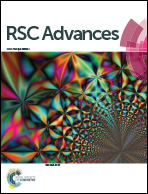Controlled synthesis and luminescent properties of DyPO4:Eu nanostructures†
Abstract
In this paper, a simple hydrothermal method was designed for the selective synthesis of Eu-doped tetragonal DyPO4 and hexagonal DyPO4·1.5H2O nanocrystals. It was found that the hydrothermal conditions (temperature and pH) and organic additive are very important in determining the crystal structures and morphology of the final products. Low temperature and low pH (120 °C, pH = 2) are favorable for the formation of the hexagonal DyPO4·1.5H2O, while high temperature and high pH (200 °C, pH = 8) would be more suitable for the production of tetragonal DyPO4. When the organic additive ethylenediamine tetraacetic acid disodium salt (EDTA) was used, products with the same crystal structures (hexagonal DyPO4·1.5H2O) and different morphologies, such as nano/submicroprisms, and nanorods could be obtained. Furthermore, the luminescent properties of DyPO4:Eu with different crystal structures and morphologies were also investigated. Compared with the hexagonal DyPO4·1.5H2O, a small blue shift of the strongest excitation peak and increase in the intensity of the emission spectra can be observed for the tetragonal DyPO4. Our capability of obtaining hexagonal DyPO4·1.5H2O and tetragonal DyPO4 can not only provide some new information in the study of polymorph control and selective synthesis of inorganic materials, but also benefits the wide applications of DyPO4 due to the improved luminescent properties.


 Please wait while we load your content...
Please wait while we load your content...